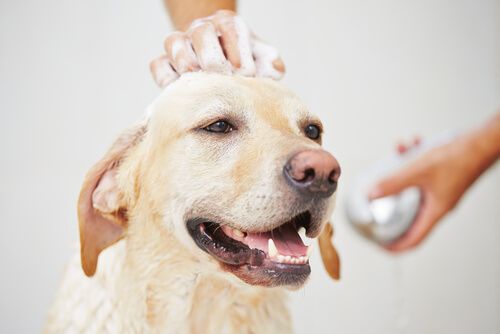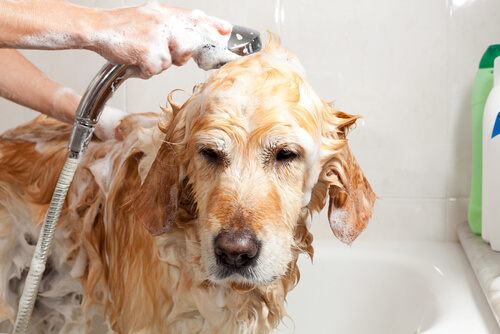Pet Care 101: Tips for Bathing Your Dog

Bathing your dog can be quite the experience! In the following article, we present a few tips for bathing your dog.
Things to consider before bathing your dog
How often you bathe your dog depends on many factors. For example, fur type, activities, breed, size, age, and time of year. If your pet spends a lot of time outdoors, he might need to be bathed more than a dog who never goes outside.
Water and soap can be scary for your furry friend. It is essential that you help him get used to it, so that he sees it as a pleasurable experience. You can put him in an empty tub so that he will not be frightened, fill it warm water from the bottom up, and give him a treat when you’re finished.
Steps for bathing your dog

When it’s bath time, it may be a challenge to get your dog to keep still and stay in the water for a few minutes. Perhaps, at the beginning, you should ask a family member or friend for help. Here are the steps for bathing your dog:
1. Choose the right place
If your pet is small in size, you can bathe him in the kitchen sink, otherwise you might bathe him in the shower or bathtub. If it is warm, bathe him outside. If it is cold, always bathe your pet indoors. Once you start wetting and and soaping up your dog, the floor will be slippery. That’s why it’s best to put a towel down so that you can step on it and feel safer. If you know he’ll get nervous, pick a room with a door so that he can’t escape.
2. Prepare the animal
Before bathing him, you should brush his fur, especially if it is thick or he has a lot of it. Be sure to remove or untangle any tangled strands. If you are willing to do so, you can trim his nails. However, it is better for a professional to do this, in order to avoid hurting your dog and causing infections.
3. Gather necessary materials
Before beginning to bathe your dog, make sure you have all the items you need, such as: a towel, shampoo or soap for dogs, cotton balls, a treat, a sponge, a brush, a cloth, etc. If your dog gets aggressive, you should muzzle or leash him.
4. Put cotton balls in his ears
If your dog’s ears get wet, they can develop infections. To avoid this, place a cotton ball in each ear to keep the auditory canals dry. There is no need to push them in very far– just make sure they are securely in place.
5. Check the water temperature
Dogs are sensitive to heat and cold. Make sure the water is warm to make him feel more comfortable. After that, start pouring water over his body, taking special care not to wet his face, ears, and eyes. It is better to wet him from the neck down. If he has thick fur, you can use a sponge or brush to make the water saturate it completely.
6. Apply the shampoo
Mix the shampoo with a little water and rub to form foam. It is always best to use your hands to spread the product well, so that the dog feels your direct touch and doesn’t panic. It is best to spread the shampoo opposite to the direction in which the fur grows, to prevent it from tangling. Pay attention to his legs, because they are usually very dirty.
7. Clean his face
Your pet’s face tends to get pretty dirty, but you can’t pour water on it like the rest of his body. Rub a damp cloth over it to remove dirt, and remember not to touch his ears.
8. Rinse
Using a hose or bucket, you can slowly pour warm water over your dog to remove all the shampoo. Rub to remove the shampoo completely. Don’t forget to rinse only from the neck down.
9. Dry

Your dog’s first reaction will be to shake off all the water. Allow him to do so, because it will help you with the drying process. If it is very cold, we recommend that you wrap him in a towel. Then, if his fur is very thick, you can dry him with a hair dryer.
10. Comb
Take advantage of drying time to comb your dog’s fur and remove tangles (and prevent new ones from forming). This will also help make his coat shinier.